9 Best Yoga Hip Stretches for Runners With Super Tight Hips

Yoga hip stretches for runners can be a game-changer for your performance and recovery. As runners, many of you may be familiar with some of the hip muscles or areas that get tight from running—likely because we can feel them in our bodies. But when it comes to tightness, the body doesn’t work in isolation.
Fortunately, yoga can help. The best yoga hip stretches for runners can make a night and day difference in your performance. Running hip tightness, get ready to get lost.
Below, we’ll walk you through yoga poses and hip stretches for runners to get your mechanisms working like a well-oiled machine.
We’ll cover:
- Yoga for tight hip flexors
- Best yoga hip stretches
- Top yoga poses to open hips
- Yoga for tight hips and glutes
9 Best Yoga Hip Stretches for Runners
Everything is connected, so it’s important to get more familiar with the different muscles that may be contributing to your tightness, the proper method for stretching and opening them, and the hip openers that will be most effective in accessing those muscles.
If you want to safely increase your range of motion in the hips and legs, use the below hip-opening yoga poses to guide you.
#1 Crescent Lunge (Anjaneyasana)

- Begin in a Downward Facing Dog. On your inhale, lift your right leg straight up and back, keeping the hips square. On your exhale, place the right foot between your hands for a low lunge and drop your left knee to the mat or floor. On your next inhale, look forward and lift the chest.
- For a deeper stretch, you can walk the hands to the top of the thigh or lift the arms up and overhead. Continue to gently press the hips forward to relieve tight hip flexors and feel the stretch in the front of the left thigh. Pull the low belly in to protect your low back and avoid low back pain.
- To repeat the other side, move back to Downward Dog and begin by lifting the left leg.
#2 Yogi Squat Pose (Malasana)
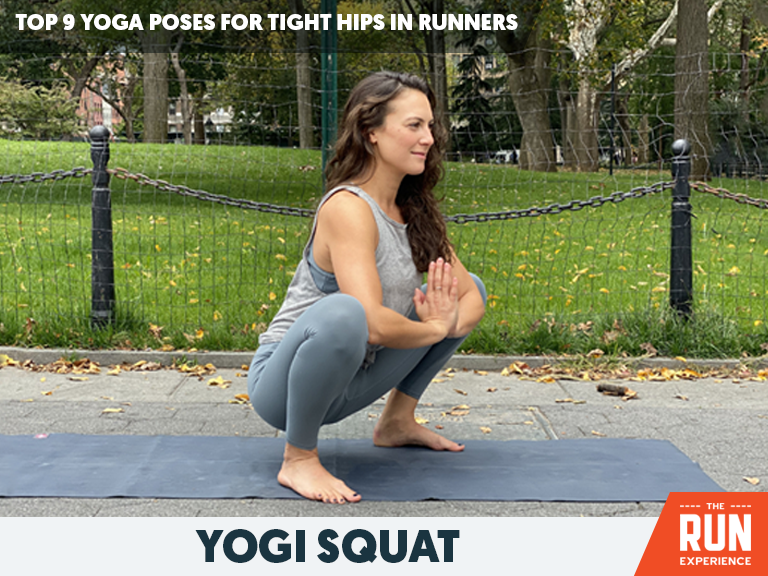
- Stand at the front of your mat. Separate your feet mat width distance, bend the knees and fold forward, bringing the hands to the mat or ground.
- Turn the toes out slightly, bend the knees more and sit the hips low. Make sure both the right heel and left heel are pressing down firmly.
- Take the palms to touch in front of the chest and make contact between the elbows and knees to press the knees in opposite directions.
- Press into the hands and lift the chest to find more length in the inner thighs and hips.
- It’s important that the heels are pressing flat into the floor. If they aren’t you may need to widen your stance or place a block or two under your seat for support.
#3 Lizard Pose (Utthan Pristhasana)
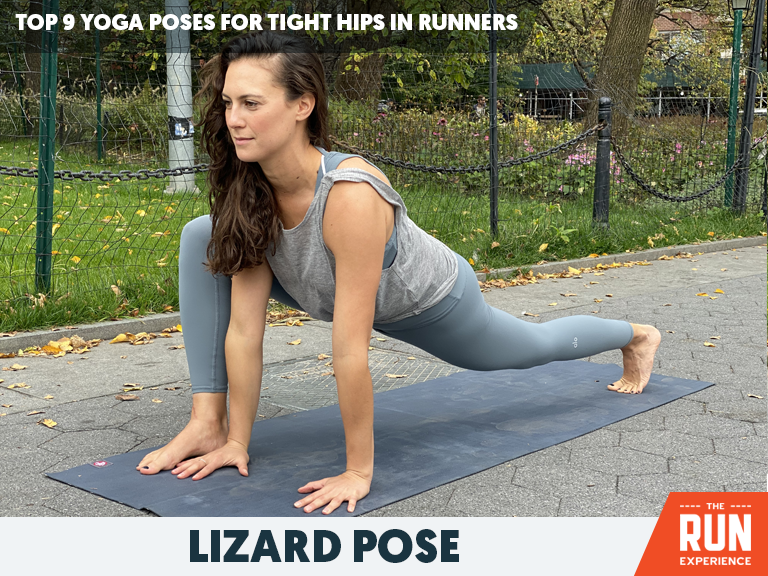
- Come to Downward Facing Dog. Lift your right leg up and back behind you for Down Dog Split. Step the foot forward outside of the right hand, and drop the back knee down.
- Stay here, or for a deeper stretch, take the forearms to the mat, and then re-tuck the left toes and left the left knee. Continue to pull the right knee in towards the right shoulder.
- Repeat on the left side.
#4 Dynamic Standing Split (Urdhva Prasarita Eka Padasana)
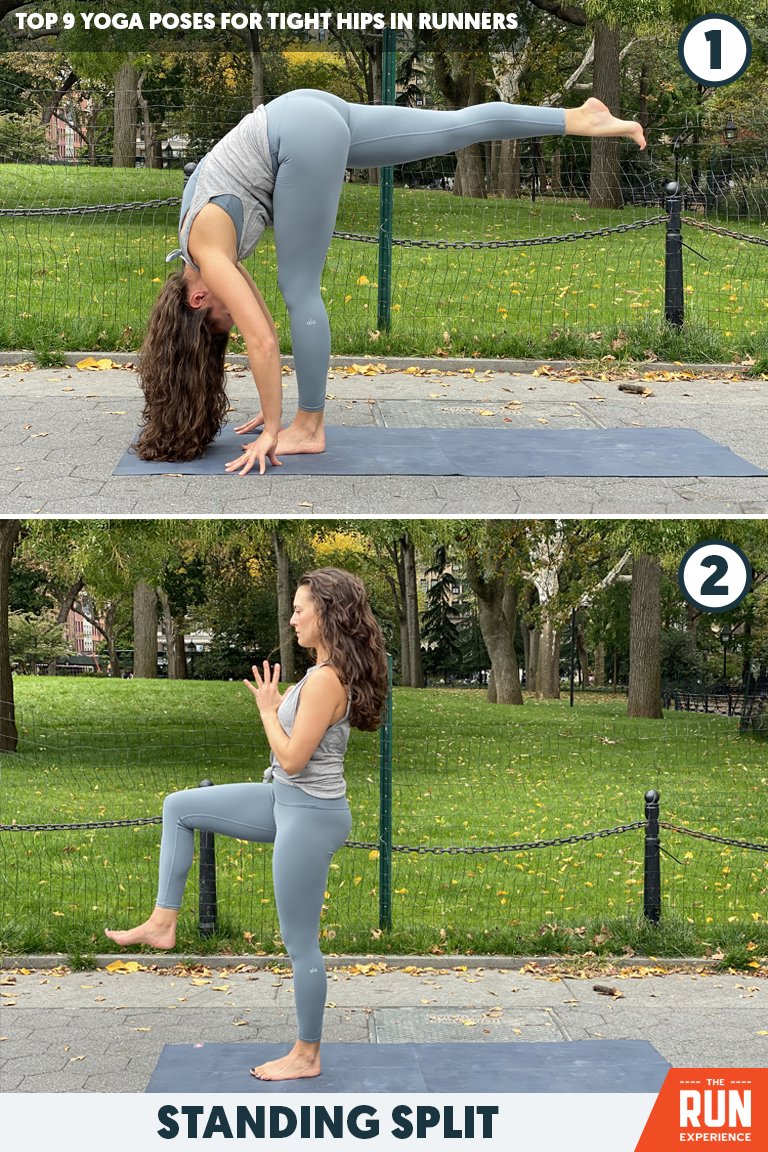
- Start at the top of your mat with your feet hip-width distance apart. Bend the knees and fold forward, placing the hands on the floor or yoga blocks.
- Use the inner thigh to lift the left leg up and back behind you, standing on the right foot. Make sure to keep the left hip even with the right one to effectively lengthen the right hamstring.
- From here, engage the right leg and abdomen to stand all the way up, lifting the left knee in towards the chest. Move slowly back to standing split.
- Repeat this movement five times on the right side and then repeat on the left side.
#5 One Legged King Pigeon Pose (Eka Pada Rajakapotanasana)

- From Downward Dog, carry the right knee forward and place it and the right shin on the mat behind the right wrist. Lower the hips to the mat, and consider using a yoga props (yoga block or blanket) under the right hip.
- Make sure the back leg is extended straight back behind you and the left ankle is in line with the knee and the top of the left foot is pressing down.
- From here, you can walk the hands forward any amount or come to the forearms.
- Repeat on the left side. Remember to breathe.
#6 Cow Face Pose (Gomokasana)
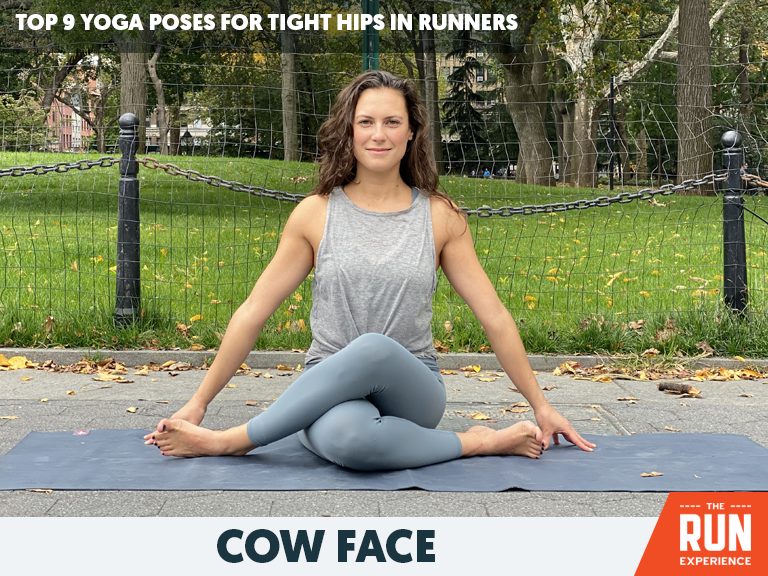
- Start in Downward Facing Dog. Cross the right ankle over the left. Bring the front knee and right shin to the mat, and tuck the left knee behind the right.
- Then, bring the tops of your feet wide, and sit your hips between your feet. It might be helpful to place a yoga block under your seat. Even though your legs are squeezed towards the center, the thigh bone should be externally rotated in your hip joint.
- Stay here or fold forward for more opening in the outer hips. Repeat the opposite side with the left knee in front.
#7 Bound Angle Pose (Baddha Konasana)
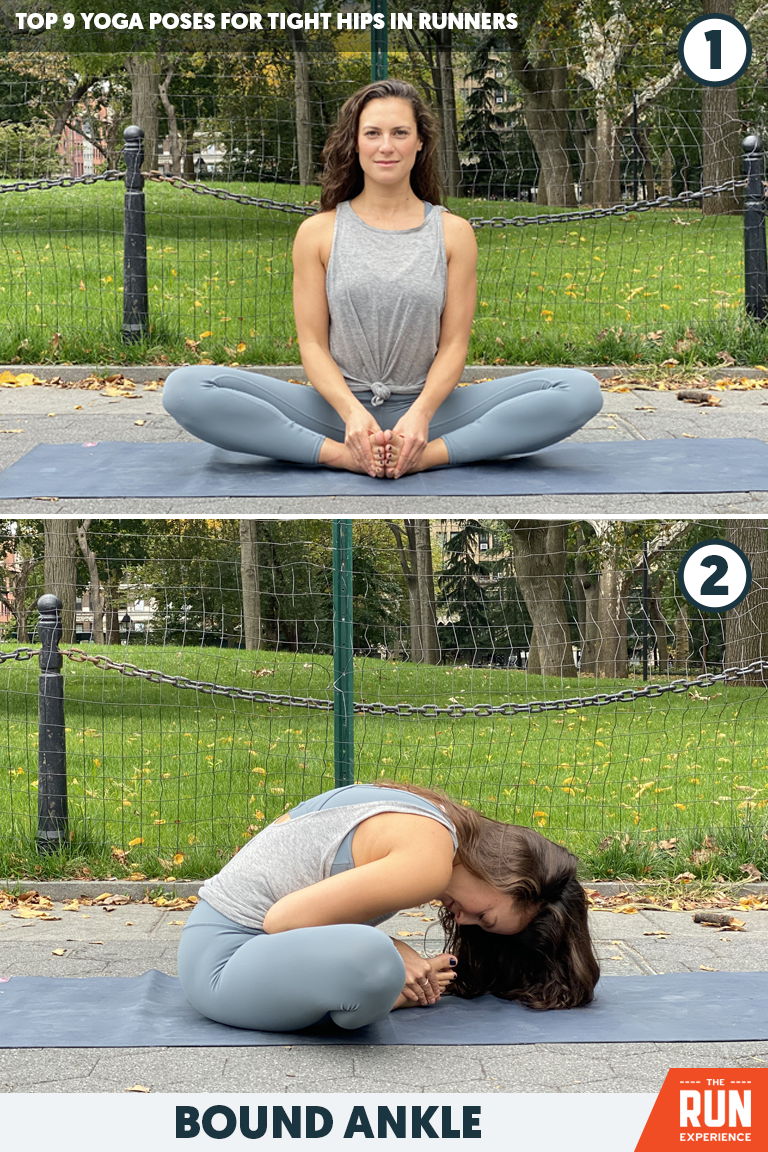
Sit on your mat, and bring the soles of your feet to touch. Pull the heels in as close as is accessible.
- Take the hands to the inner edge of either foot, pull the elbows in towards your ribs and fold forward.
#8 Half Frog Pose (Ardha Bhekasana)
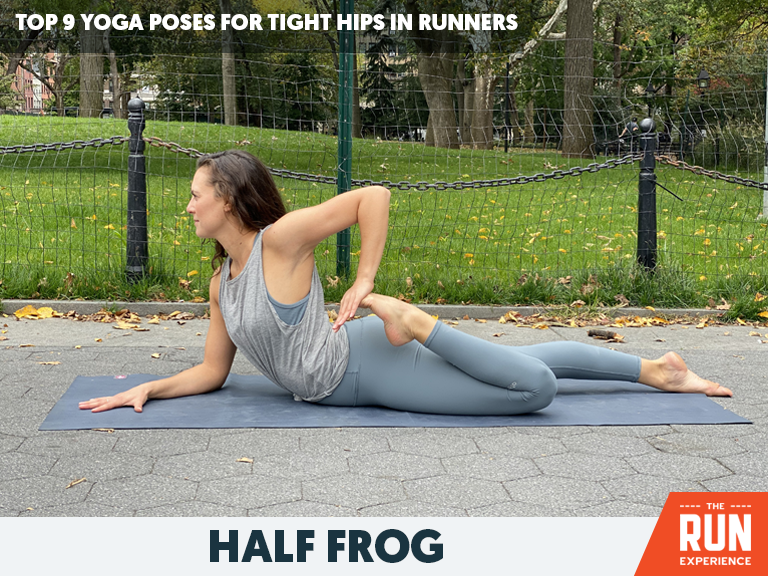
- Lay on your belly with your legs outstretched behind you. Prop yourself up on your forearms, making sure that each elbow is stacked underneath each shoulder. Lift the chest up and through the shoulders.
- Then, slide the right hand to the left at a 45-degree angle, so it’s pressed into the floor, and in line with your sternum. Bend the left knee, so the heel comes toward you.
- Reach back with the left hand and catch the inner edge of the left foot. Pull the heel down towards the left outer hip any amount and turn the chest to face forward.
- Press into the right forearm to keep the chest lifted to feel an opening in the left hip flexor.
#9 Happy Baby Pose (Ananda Balasana)

- Find your way to your back on the mat. Pull the knees into the chest, and then take the knees wide towards your armpits.
- Reach the hands inside the knees and catch the outer edge of either foot, ankle or behind the knees and pull the knees closer to the armpits.
- Keep your whole back pressed down onto the mat, even including your low back, and think about reaching your tailbone away from your shoulders to lengthen the spine.
Why Do We Get Tight Hips in the First Place?
Regular and long-distance running is known to cause muscle tension in and around the hips, but our general way of life also contributes to hip tightness because of how much time we spend sitting.
Heathline says that sitting can have short- and long-term effects on your health and body, making this seemingly benign activity potentially deadly.
According to this study on prolonged sitting, “The most common injuries occur in the muscles, bones, tendons and ligaments, affecting the neck and lower back regions. Prolonged sitting reduces body movement making muscles more likely to pull, cramp or strain when stretched suddenly.
Both running and sitting will shorten the hip flexors and psoas because of how much work is demanded from the quads and because most of us have less than optimal posture in our sitting positions. Over time, sitting can weaken the glutes, causing instability in the low back or causing lower back pain, which is very important for running safely.
Lastly, running regularly will tighten the hamstrings and sitting long periods of time will weaken them. Both causes will end up shortening your gait, and cut time off your PR if not countered with eccentric exercises, which lengthen while strengthening.
Besides these main muscles, the inner leg muscles and outer hips also stabilize all movements that support running and moving in general, so it’s equally important to give attention to these areas too.
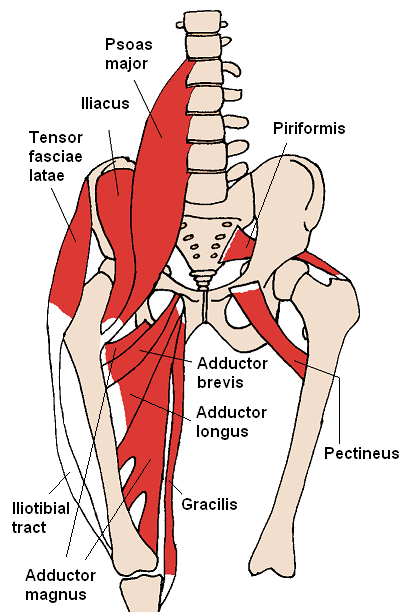
Image by Beth Ohara via Wikipedia
If You’re Gonna Stretch It, Make Sure You’re Doing it Well
When Should You Do Yoga for Runners?
Make sure you’re not stretching when your muscles are cold or don’t have any blood flow. Harvard Medical School says, “We used to believe that stretching was necessary to warm up the muscles and prepare them for activity. However, mounting research has shown that stretching the muscles before they’re warmed up can actually hurt them.”
How Long Should Runners Do Yoga?
According to the International Journal of Sports Physical Therapy, if you’re under 60 years old, for static stretches, it’s recommended to hold each stretch for 15-30 seconds for 2-4 times each, 2-3 times per week. If you’re over 60, hold for 60 seconds.
More Yoga for Your Tight Hips
Maria is a certified yoga teacher from Brooklyn, NY! To follow along with Maria herself, check out more of her online yoga classes, including this “Quick Routine for Stiff Hips,” this 60-minute full flow “Yoga for Stiff Hips” or this 30 minute “Post Workout Flow for your Lower Body,” all guaranteed to help open those hips.
Start incorporating these yoga hip stretches for runners into your regular routine to see a difference in your performance (and how you feel). Yoga can be a game-changer for your hip flexors. If you’re feeling tight or injured, we recommend you get to work ASAP—and even if you’re not, add these stretches to your routine to avoid tightness later.

